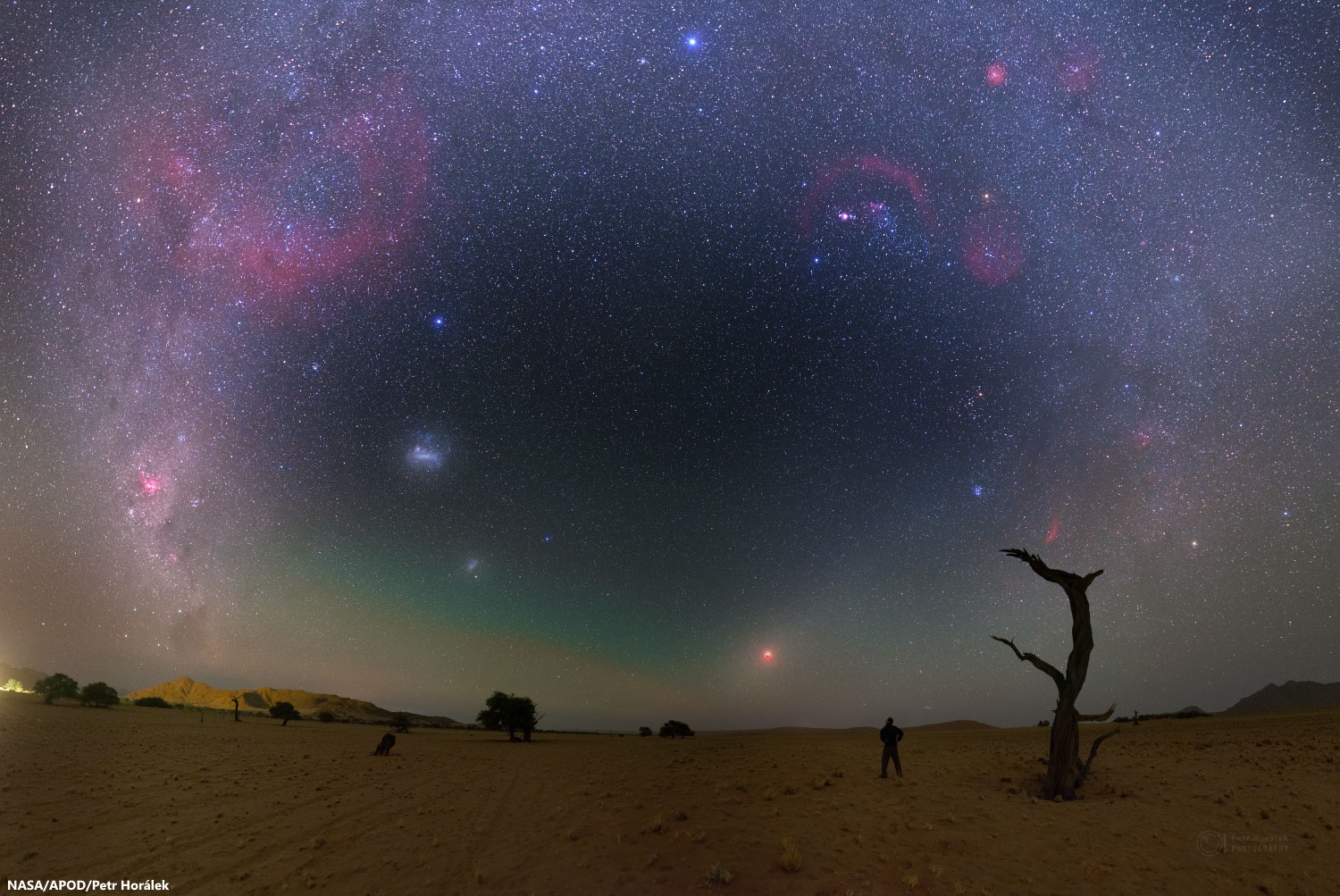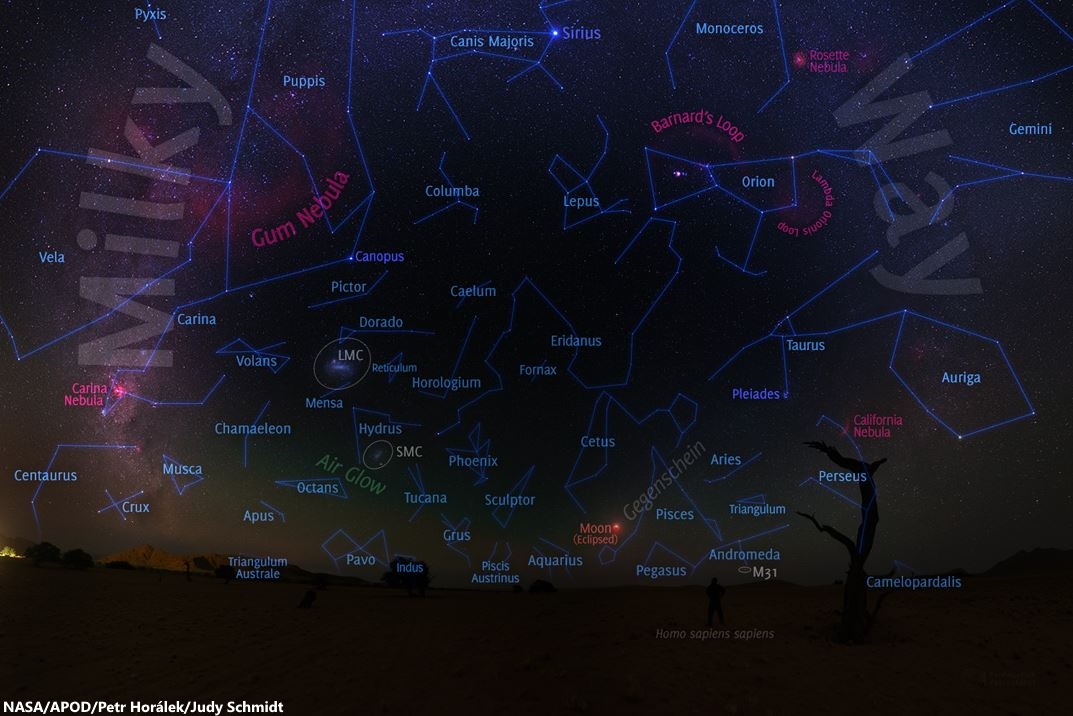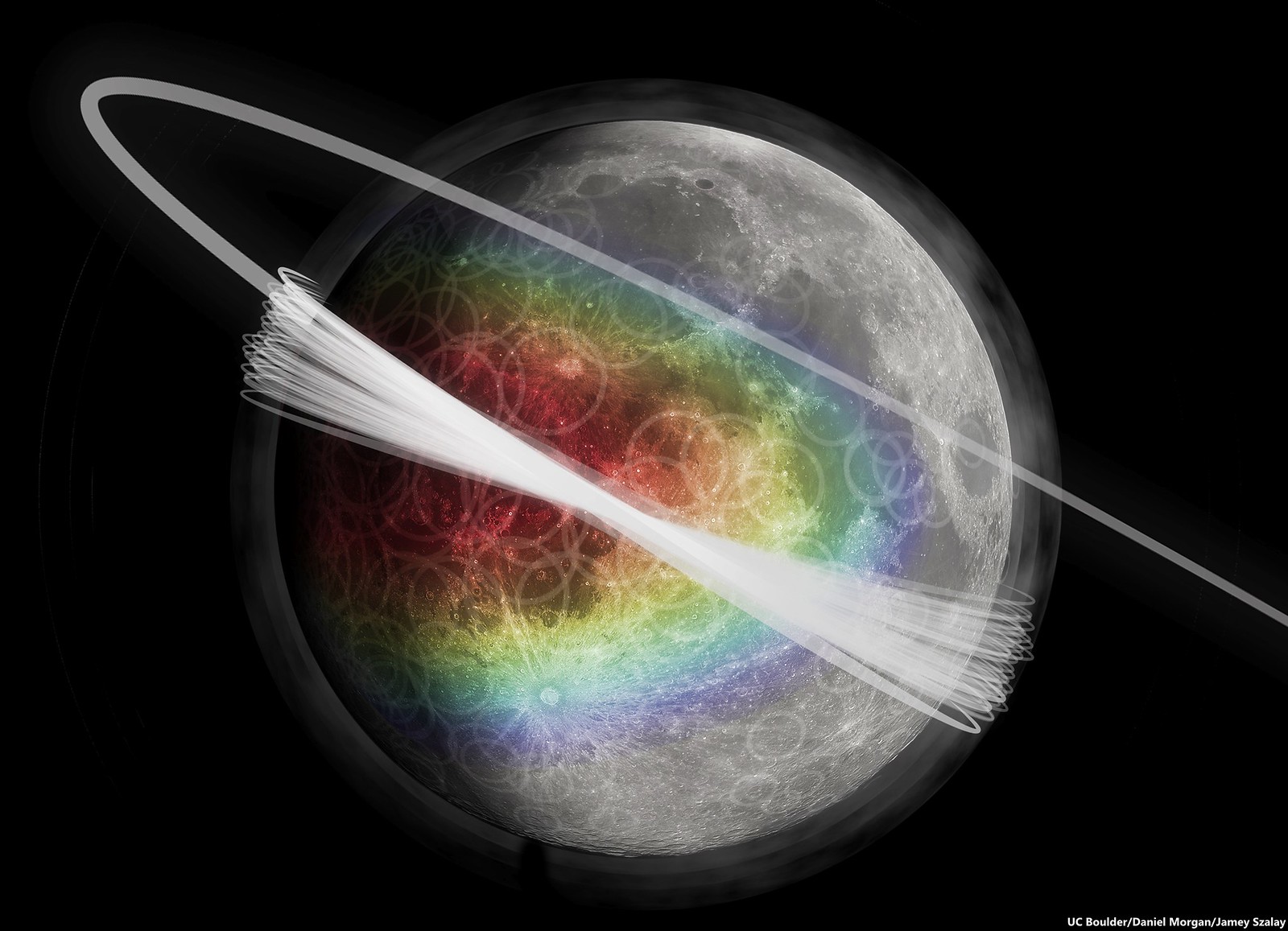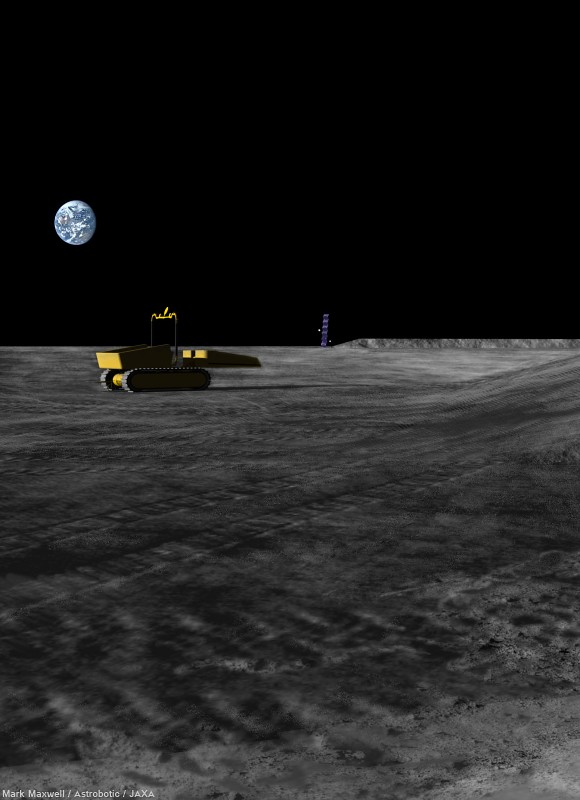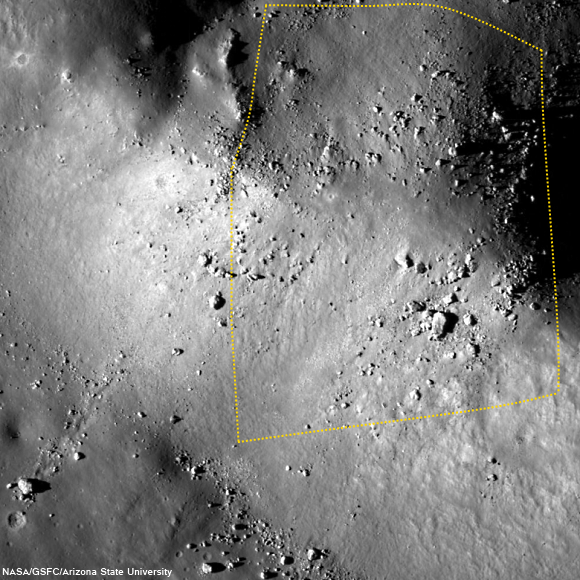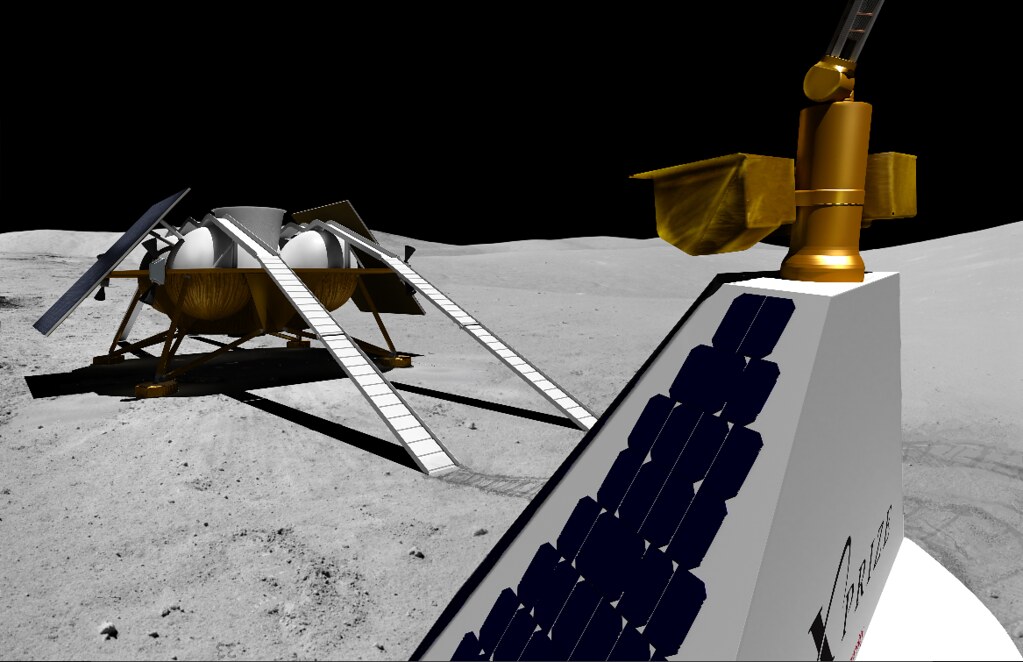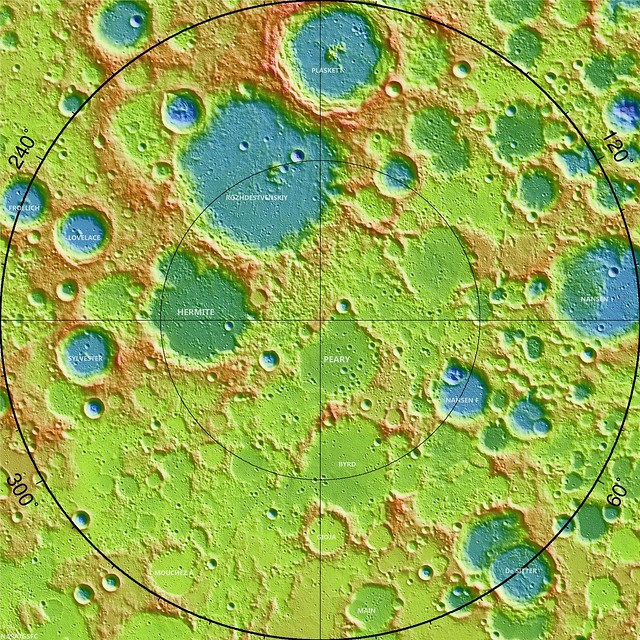 |
| North is to the left, west below in this animation showing what is almost certainly an impact and its plume (right) on the lunar surface in Mare Nubium, on the morning side of the terminator, February 26 [Marco Iten/GLR Group]. |
Marco Iten
Raffaello Lena
Stefano Sposetti
Geological Lunar Research Group
Report from Selenology Today Preliminary Report 2015:
Abstract: We report the detection of an interesting luminous event most probably generated by a meteoroidal impact on the lunar surface occurred at 21h 35m 22.871s ± 0.010s UT, the 26 February 2015. The position of the flash was along the terminator at selenographic coordinates 7.9° ± 0.6° W; 26.1° ± 1.6° S. The brightness of the flash 0.16 s after the initial detection was +8.0 magV. After the main lightdrop a successive residual diffuse light lasted for several seconds.
Under the assumption of a meteoroidal impact we argue that this post luminous event and its ever growing dimensions was likely caused by the sunlight reflection on ejected materials released by the impact. Thus, future high resolution orbital data, e.g., from LRO spacecraft (NAC images) could allow the detection of this crater. Because this event was captured only by one observer, we checked for satellite glints and evaluated the likelihood of a meteor hitting head on our atmosphere.
1. Instruments observing methods, location The detection was made by Marco Iten from Gordola, Switzerland. He used a 125 mm refractor with a focal length of 800 mm. He also used an 8bit Watec 902H2 Ultimate videocamera working in CCIR mode with these settings: Gamma = OFF; BLC = OFF; AGC = LO. A GPS time inserter (KIWIOSD) printed the Universal Time with millisecond precision in the video frames. The software Virtualdub was used to record the AVI file in a hard disk, with Huffyuv video compressor.
Iten's observatory is located at:
Lat: 46d 10m 44s North
Long: 08h 52m 29s East
Alt: 215 m
Stefano Sposetti was simultaneously filming the Moon from its observatory, but the lunar region where the flash occurred was outside its field of view.
Detection: The initial flash occurred at 21:35:22.871 ± 0.010UT, 26 February 2015 (
Fig. 1.). Marco Iten discovered it visually using no dedicated searching software.
Here some informations about the Moon at the detection instant, accordingly to sky simulator software TheSkySix ®.
Equatorial 2000:
RA: 05h 23m 27s
Dec: +17°44'32"
Horizon:
Azim: 250°41'00"
Alt: +41°21'54"
Phase (%): 62.19
Air mass: 1.51
Moon angular diameter: 0°30'33"
Moon distance (km): 3.910 E+05
Artificial satellites: We checked for artificial satellites in the field of view using the website
http://www.calsky.com.
The satellite Molniya 340 (21196 1991022A) was at an angular distance of 32 arcmin from the Moon center at the time of the detection. We exclude that this satellite caused the detected flash in Iten's avi.
Luminosity evolution
From the very beginning of the event to +0.14 s (the first seven 20 msfieldintegrationtime) the intensity of all, or at least some, of the pixels is saturated.
The luminosity of the flash at +0.16 s (in the eight field) is +8.0 ± 1.0 magV (
Fig. 2). The intensity decreases again for about a half second. From that instant on, we notice an increase in the intensity of light and also an increase of the diameter of the source. The temporal evolution of the luminosity is showed in figure 3 and was made with the software Limovie©.
For the photometry we used the star GSC 13002062 = TYC 130020621 with these characteristics:
B 10.97 ; V 9.54 ; R 8.88. The star was visible at 20:25:20 UT.
The peak brightness of the flash was between +5 and +6 magV, but this is a very rough estimation because of the saturated pixels at that instant. The solar elevation on the impact point was determined to 0.9°, computed using the LTVT software package by Mosher and Bondo (©2006) for the date February 26 2015 at 21h 35m 22.871s. Thus, the flash occurred in the dark side near the terminator.
Spatial increase of the light source
The angular sampling of the individual images composing the video file is 2.4 arcsec/pixel. We noticed a non circular increase of the light source, therefore we calculated its augmentation with respect to x and y components (
Fig. 4). The apparent radius of the Moon is almost parallel to the x axis.
At the location of the event, the absolute sampling of the image (normal to the moon radius, ie. of the y axis), is 4.5 km/pixel (on the lunar surface). The absolute sampling of the image in the x direction has to be multiplied by a factor 1.24 (= 1/sin 54°) i.e. to 5.6 km/pixel.
At time +6.62 s the x and y diameter of the external border of the “lightcloud” are about 10 pixels and 12 pixels, respectively. This translates to an effective length on the lunar surface of 54 km and 56 km.
If we assume that the increase of the light source is due to the ejected materials elevated from the bottom and if this cloud has a circular shape relative to a tangent plane to the surface, then the mean speed of the augmenting radius is about 4 km/s.
The increase of the lightsource is showed in figure 5 and in some animations we posted at
A visual inspection of the “lightcloud” in the video animation confirms that the expansion lasted until +10s. This translates to a circular effective diameter of about 80 km.
Selenographic Lunar coordinates
The coordinates of the detected flash are determined to:
Long: 7.9° ± 0.6° West
Lat: 26.1° ± 1.6° South
in Mare Nubium, near the crater Lippershey P, located to the south of Birt crater.
The analyzed image displays lunar features that were of very low contrast on the dark limb of the imaged lunar surface. Thus, after alignment with the edge of the lunar disk, computation of the libration, and overlay of the rotated Moon's surface matching the image generated by a simulated image obtained with the LOLA DEM, a coordinate map was superimposed. This procedure was performed using the LTVT software package by Mosher and Bondo (2006). Generating an elevation map of a part of the lunar surface requires its three dimensional (3D) reconstruction. Recently, a global lunar digital elevation map (DEM) obtained with the Lunar Orbiter Laser Altimeter (LOLA) instrument on the Lunar Reconnaissance Orbiter (LRO) spacecraft has been released. It has a lateral resolution of 1/64 degrees or about 500 m in the equatorial regions of the Moon
http://pdsgeosciences.wustl.edu/missions/lro/lola.htm
Hence, the rendered image obtained using LTVT and the LOLA DEM, assuming the same illumination conditions and librations of the observing session, was saturated allowing a close comparison with the appearance of the saturated terminator as seen in
Fig. 2, and further refined considering the uncertainty comparing the map with the WAC imagery of the Lunar Reconnaissance Orbiter.
Active Meteor Showers
Figure 6 shows the active meteor showers accordingly to the predictions of the software Lunarscan©. Because of the small activity of the showers at that date, we think of a sporadic nature of the meteor shower.
Evaluating the possibility of an headon meteor strike
We report this luminous event as an “unconfirmed lunar flash” being considered an impact candidate. In fact, considering that the event was only recorded by one video camera the possibility of a meteor "headon" producing the recorded light cannot be ruled out. Therefore we tried to evaluate the post spread of light as being emitted by the ionization of the high altitude gases of our atmosphere. Sometimes luminous meteors leave luminous trails and in this chapter we try to discard this possibility. We got the direction of the winds and their speed using the website
http://weather.uwyo.edu/upperair/europe.html published by the University of Wyoming©. Here we could download data from balloons sent from Milan (LIML) and from Payerne (LSMP), the 2 nearest stations from Iten's observatory at 12h intervals (00h and 12h). The balloons reach about 30 km of height. At that altitude and also some kilometers higher, the direction of the winds during the time interval between Feb 26.5 and Feb 27.0 is around 270 deg and their speed from 30 to 40 knots (LIML data) and from 30 to 99 knots (LSMP data). Projecting the wind speed along the normal direction of the line of sight, one gets, with a conservative wind speed of 18 m/s in the interval of 6.6 s, a drift of about 350 arcsec. This is about 12 times more than the drift in East direction of the “lightcloud” in the same interval. The western direction of the winds cannot explain the drift of the “lightcloud” in almost a circular shape. Hence we confidentially exclude that the drift of the “lightcloud” was caused by winds at 30 km height.
Size of the probable impactor and of the produced crater
In this study, and under the assumption of an impact event, the same formalism and equations as in the works by Bellot Rubio et al. (2000), Ortiz et al. (2000), Ortiz et al. (2002), and Carbognani (2000) was followed, including the kinetic energy that is translated into impactor mass assuming a typical sporadic impactor speed. According to the statistics of a large meteoroid orbit database (Steel, 1996) this speed is approximately 20.2 km s1 on Earth and 16.9 km s1 on the Moon, after correcting for the different escape velocities of the Earth and the Moon.
Moreover a short routine provided by Melosh and Beyer (1999) was used to evaluate the scaling equations to determine the diameter of a crater given details on the nature of the projectile, conditions of impact, and state of the target. The transient crater diameter is evaluated by three independent methods, yield scaling, piscaling and Gault's semiempirical relations supplemented by rules on how crater size depends on gravity and angle of impact.
The parameters used in the calculation are the projectile density, the target density (2700 kg m3), the impact velocity (16.9 km s1), the peak brightness (5.5 MagV) and the duration of 0.22 seconds. Using the luminous efficiency η = 2 x 103 (the nominal value determined from Leonid impact flashes, e.g., Bellot Rubio et al., 2000; Ortiz et al., 2002), the mass of the impactor would be 1.1 kg. Based on the above data and assuming a spherical projectile, the diameter of the impactor was inferred to be approximately between 9 and about 20 cm considering a bulk density ranging between 0.3 g cm3 (soft cometary material) to 3.7 g cm3 (corresponding to ordinary chondrites). This impactor would strike the target with an impact energy of 1.7 x 108 Joules (4.0 x 108 MegaTons). If the meteoroid is associated as a sporadic source, the impact angle is unknown. We have used the most likely angle of 45° to estimate the size of the crater produced by the impact.
Using the Piscaled law for transient craters, the final crater would be a simple crater with a rim to rim diameter of about 1520 m.
However, considering that the brightness of the detected flash was saturated and the described presence of a luminous post event, the values inferred for the mass of the probable impactor and the crater size originated by the impact could be considerably higher.
Future high resolution orbital data, e.g., from LRO spacecraft (NAC images) could allow the detection of this crater. Hence, it will be interesting to compare LRO high resolution images (NAC images with their resolution of ~1 m on the ground) taken before and after the event. Future studies will be performed to complete our analysis, including the search of the crater, and thus to estimate mass of impact produced dust cloud and the size of exospheric dust particles and to perform hydrodynamic modeling of this event.
Acknowledgements:
Data about winds are obtained in collaboration with Meteoswiss
We thank the Wyoming University for the source winds data set
References:
[1] Sposetti, S., Iten, M., Lena, R. 2011. Detection of a meteoroidal impact on the Moon. Selenology Today 23,132.
[2] Lena, R., Iten, M., Sposetti, S., 2011. Detection of three meteoroidal impact on the Moon. Selenology Today 24,1229.
[3] Lena, R., Iten, M., Sposetti, S., 2011. Detection of two probable meteoroidal impacts on the Moon. Selenology Today 25,6065.
[4] Iten, M.,Lena, R., Sposetti, S., 2013. Five probably meteoroids impact on the Moon. Selenology Today 31,1015.
[5] Lena, R., Manna, A., Sposetti, S., 2013. Detection of a probable small meteoroidal impact on the Moon. Selenology Today 33,49.
[6] Bellot Rubio, L.R., Ortiz, J.L., Sada, P.V., 2000. Observation and interpretation of meteoroid impact flashes on the Moon. Earth Moon Planets 82–83, 575–598.
[7] Carbognani, A.2000. Impatti sulla Luna
[8] Steel, D., 1996. Meteoroid orbits. Space Sci. Rev. 78, 507–553.
[9] Ortiz, J.L., Sada, P.V., Bellot Rubio, L.R. et al. (2000) Optical detection of meteoroidal impacts on the moon. Nature 405. 921923.
[10] Ortiz, J.L., Quesada, J.A., Aceituno, J., Aceituno, F.J., Bellot Rubio, L.R. 2002. Observation and interpretation of Leonid impact flashes on the Moon in 2001. Astrophys. J. 576. 567–573.
[11] Melosh, H.J., and Beyer, R. A. 1999. Computing Crater Size from Projectile Diameter.
[12] Mosher, J., & Bondo, H., 2006. Lunar Terminator Visualization Tool (LTVT).

